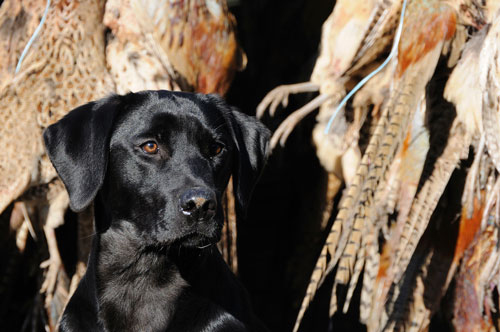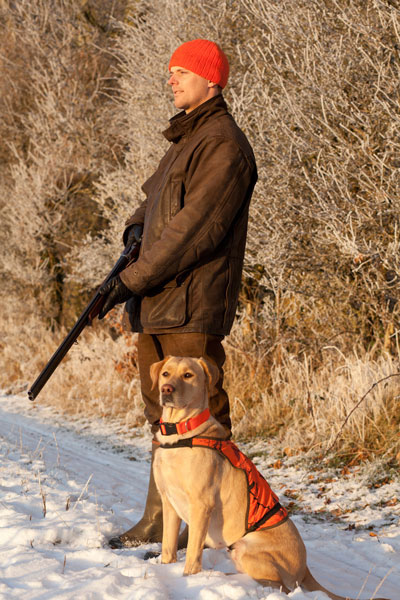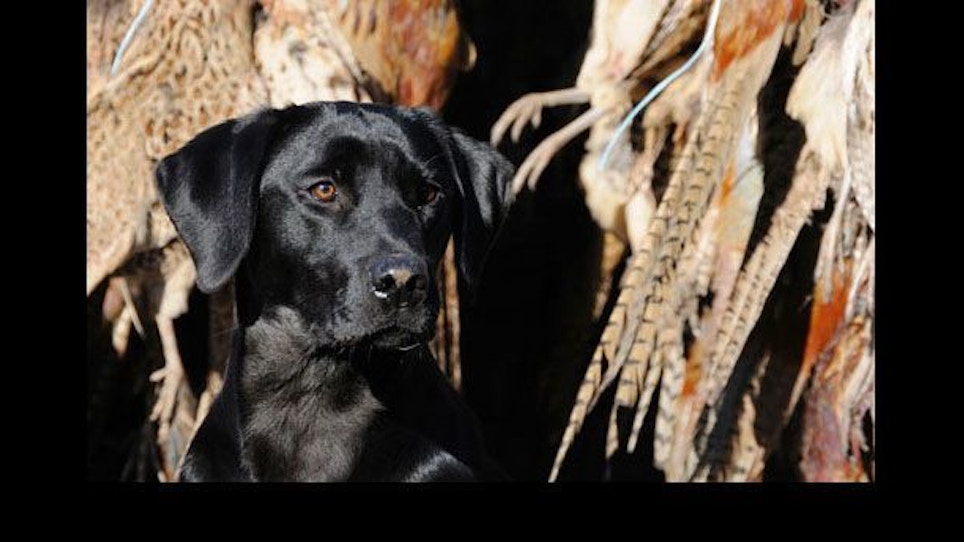 How do you get a retriever to hunt in the uplands? Here’s what you don’t do: turn it loose with little or no training to see how it does.
How do you get a retriever to hunt in the uplands? Here’s what you don’t do: turn it loose with little or no training to see how it does.
“Absolutely not,” Kris Hunt says. “Not if you ever want to hunt with it, anyway.” Hunt and her husband, Johnny Betts, own Blacktail Labradors in Butte, MT. Hunt came to my attention — highly recommended — from a good friend whose dog she trained for both upland and waterfowl work. When the opportunity arose to write this story, I gave her a call. She and her husband were up to their elbows in dogs at the moment, but she graciously agreed to talk to me.
Before any retriever is ready for the field, the first order of business is teaching the basics, she told me. “The first thing I do with any dog is obedience,” she said. “Our dogs are up in the morning, they go through their drills…and then I make sure that they’re birdy. Obviously they have to be birdy; the birdier the dog, the better.”
Hunt introduces her pups to dead birds first. “I start with a fresh, dead bird,” she said. “You don’t want to introduce them to a stinky, gross bird; it should be fresh and warm. I entice them with it, let them play with it. Basically, I teach them that it’s great and that the bird is what they’re looking for.” She does, however, limit their initial exposure. “I don’t let them have the bird for long because it can start mouth problems,” she says.
Next, Hunt segues into conditioned retrieves. Conditioned retrieves — also known as force breaking — is a subject unto itself, and too extensive to go into here. But when the process is over, which usually takes six or eight weeks, the dog is reintroduced to birds.
“I start again with dead birds,” she says. “They’ve seen plenty of dead birds as part of the conditioned retrieve training — it’s part of teaching them to hold — so next we release live birds (pigeons) in the field and let the dogs flush them without shooting them. Finally, we shoot live flyers for them.”
Dogs that aren’t totally focused on the bird at this point are rare, according to Hunt, but it does happen, especially with older dogs. “I’ve had dogs come to me at one or two years of age that have never had a feather in their mouth. As far as they know, that (the bird) is something they’re not supposed to get. So I have to go real slow. The first day, I’ll put out a bird, and if all they want to do is walk out and sniff it, then I’ll call it good and do it again the next day. If even that’s too much for them, I’ll wait and do something else, usually obedience, and usually as boring as I can make it. Then, when you give them a bird again, and you’re playing around with it, they suddenly think, ‘Wait! This is kind of fun!’ ”
At that point, Hunt’s dogs have learned basic obedience and conditioned retrieves, and they have been introduced to live birds — standard procedure for any working retriever. Now they’re ready to begin a drill specifically geared for upland birds: quartering. Quartering drills take time, patience and helpers, but they’re essential for training any upland flusher.
 “We train our dogs through a combination of things that all come together,” Hunt says. “We start with the command ‘find it,’ which tells the dog to put its nose down and look for a bird. To teach the dog this, we have three people in a line: one in the middle working the dog, and two people, one on either side of the middle person, who have birds (pigeons) they wave at the dog. The people on the side are waving the bird and teaching the dog to run back and forth in a quartering pattern at about the distance from the middle person that you want the dog to learn to quarter in the field. That’s typically about 20 yards to either side and no farther in front than you think you can hit the bird.”
“We train our dogs through a combination of things that all come together,” Hunt says. “We start with the command ‘find it,’ which tells the dog to put its nose down and look for a bird. To teach the dog this, we have three people in a line: one in the middle working the dog, and two people, one on either side of the middle person, who have birds (pigeons) they wave at the dog. The people on the side are waving the bird and teaching the dog to run back and forth in a quartering pattern at about the distance from the middle person that you want the dog to learn to quarter in the field. That’s typically about 20 yards to either side and no farther in front than you think you can hit the bird.”
By now, your dog should be almost ready for an actual hunt, but before you go into the field, make sure it’s up to speed on everything it needs: a good quartering pattern, a reliable retrieve to hand, an ability to execute simple blind retrieves, and a solid foundation in obedience, particularly the sit (on the whistle) and recall commands. The sit command, Hunt says, is critical.
“You don’t know what you’re getting into when you’re hunting,” she says. “Your dog might spook up a rabbit, it might chase a deer, a vehicle might drive into the area or the dog might be getting ready to hit a fence. So for the safety of your dog, the recall command and especially the sit command are very important.”
Now the big day has arrived, and your dog is on his first hunt. After all the months of preparation and training you’ve invested, don’t let your dog go to pieces the moment a bird goes up.
“When my clients take a dog into the field for the first time, I tell them to leave their gun at home, take their collar controllers (e-collars) and whistles, and concentrate on training and working just that dog,” Hunt says. “Your dog is going to need your undivided attention for the first few hunts. Hunts are different from training, so just concentrate on working the dog.” Ideally, Hunt also likes to partner with just one other person to keep distractions to a minimum.
Eventually, when your dog learns his way around the uplands, hunting becomes less a matter of training and far more like teamwork. Then, when he puts up a bird that you wing tip — “Those birds can move!” Hunt laughs — your dog will know exactly how to handle it.






